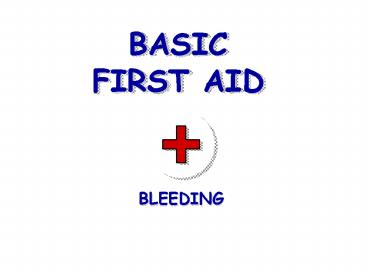BASIC FIRST AID - PowerPoint PPT Presentation
1 / 14
Title:
BASIC FIRST AID
Description:
While administering first aid to a casualty who is bleeding, you must remain calm. ... They frighten the individual and may bleed enough to cause shock. ... – PowerPoint PPT presentation
Number of Views:101
Avg rating:3.0/5.0
Title: BASIC FIRST AID
1
BASICFIRST AID
- BLEEDING
2
INTRODUCTION
- The information provided to you in the first aid
series is meant to supplement your training and
is to inform you of the injuries that you may be
faced in a wilderness situation. - KEEP IN MIND SAFETY FIRST AND ALWAYS BE PLANING
FOR THE WORST CASE SCENERIOS.
3
BLEEDING
- While administering first aid to a casualty who
is bleeding, you must remain calm. The sight of
blood is an emotional event for many, and it
often appears severe. However, most bleeding is
less severe than it appears. Most of the major
arteries are deep and well protected by tissue
and bone. Although bleeding can be fatal, you
will usually have enough time to think and act
calmly.
4
BLEEDING
- There are three classifications of bleeding.
- Capillary- Capillary bleeding is slow, the
blood "oozes" from the (wound) cut. - Venous- Venous bleeding is dark red or
maroon, the blood flows in a steady stream. - Arterial- Arterial bleeding is bright red,
the blood "spurts" from the wound. - Arterial bleeding is life threatening and
difficult to control.
5
BLEEDING
- There are three methods to control bleeding
- direct pressure
- elevation
- indirect pressure.
6
BLEEDING
- Direct Pressure
- Place a sterile dressing or clean cloth on the
wound, tie a knot or adhere tape directly over
the wound, only tight enough to control bleeding.
If bleeding is not controlled, apply another
dressing over the first or apply direct pressure
with your hand or fingers over the wound. Direct
pressure can be applied by the casualty or a
bystander. Under no circumstances is a dressing
removed once it has been applied.
7
BLEEDING
- Elevation
- Raising (elevation) of an injured arm or leg
(extremity) above the level of the heart will
help control bleeding. Elevation should be used
together with direct pressure.
8
BLEEDING
- Indirect Pressure or Pressure Points
- In cases of severe bleeding when direct pressure
and elevation are not controlling the bleeding,
indirect pressure must be used. Bleeding from an
artery can be controlled by applying pressure to
the appropriate pressure point. Pressure points
are areas of the body where the blood flow can be
controlled by pressing the artery against an
underlying bone. Pressure is applied with the
fingers, thumb, or heel of the hand.
DIRECT
PRESSURE
9
BLEEDING
- Pressure points should be used with caution.
Indirect pressure can cause damage to the
extremity due to inadequate blood flow. Do not
apply pressure to the neck (carotid) pressure
points, it can cause cardiac arrest.
10
BLEEDING
- Penetrating Objects
- DO NOT remove the object. Stabilize the object by
using bulky dressing around the object and secure
it in place.
11
BLEEDING
Wrap in dry sterile or clean bandage or cloth.
- Severed Body Part
- Control Bleeding
- Contact 911
- Wrap up body part in sterile or clean cloth.
- Place in a plastic zip lock bag and place in cold
water.
COLD WATER
12
BLEEDING
- Nose Bleed
- Nosebleeds can be caused by an injury, disease,
the environment, high blood pressure, and changes
in altitude. They frighten the individual and may
bleed enough to cause shock. - If the bleeding is due to a head injury and you
suspect a fractured skull, do not stop the
bleeding. Cover the nose with a loose, dry,
sterile dressing and call the local emergency
number or medical personnel.
13
BLEEDING
- If the individual has a nosebleed due to other
causes, do the following - 1. Keep the individual quiet, sitting with head
tilted forward. - 2. Pinch the nose shut (if there is no fracture),
place ice or cold packs to the bridge of the
nose, or put pressure on the upper lip just below
the nose. Seek medical assistance if the
nosebleed continues, bleeding starts again, or
bleeding is because of high blood pressure. If
the individual loses consciousness, place them on
their side to allow blood to drain from the nose
and call the local emergency number(911).
14
FIRST AID / CPRCLASSES































